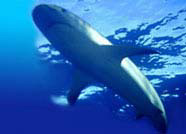


Dusky shark

 |
 |
 |
|||
| Home | Evolution
| Classification
| Glossary | Biology
| Behavior | Shark
Repellent | Shark
Conservation | Do's &
Don'ts | Did You Know?
Dusky shark |
 |
||||
|
Scientific name: Carcharhinus obscurus
 The
dusky shark gets its name from its dark, indistinct coloration. It undertakes
long, seasonal, temperature-related migrations. It is a relative of the
"Carcharhinus brachyurus"(the copper shark) with which it is
confused in Australia because of its color. The
dusky shark gets its name from its dark, indistinct coloration. It undertakes
long, seasonal, temperature-related migrations. It is a relative of the
"Carcharhinus brachyurus"(the copper shark) with which it is
confused in Australia because of its color.These sharks can live up to 40-50 years. This large, slender shark has a short rounded snout. It is slate blue to mid-grey dorsally, fading to white ventrally with an indistinct lighter horizontal band on the flanks. It is found off continental coasts including the Mediterranean, Red Sea and, commonly, southeast Africa. It is a coastal species inhabiting warm-temperate and tropical waters, it is found on continental and insular shelves, both offshore and inshore from the surface down to 400m. The dusky shark eats numerous bony fish, other sharks, rays, octopuses and other cephalopods and crustaceans. They will also scavenge on whale carcasses. They are migratory by nature. It is not considered a particular threat to humans, its main predator is it's close relative- the bull shark. Fertilization in them takes place internally, resulting in 3-14 pups. The females move briefly inshore to give birth and, apparently, mate each alternate year, with parturition occurring over a period of several months. They are viviparous, the young being nourished by a placenta Dusky sharks are regularly taken on commercial longlines, and fished for their fins. The International World Conservation Union (IUCN) site them as being of lower risk, but near threatened. Statistics: These sharks can grow to about 3.5m. Dusky Shark Classification:
|
|||||
| Sitemap | Reach To Us | Jimtrade - Business Directory of India | |||||